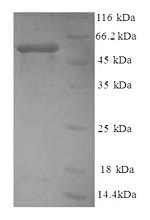Recombinant Human Myosin-9/MYH9 produced in E.coli contains 240 amino acids covering the partial-length of MYH9 protein (2-241AA). And it has its N-terminus fused with a GST-tag and a total molecular weight of 54.2 kDa. The purity of this human MYH9 protein is greater than 90% measured by SDS-PAGE. This protein is in-stock, which means there is no waiting period for protein preparation. This recombinant MYH9 protein may find uses in the specific antibody synthesis or the studies of the cell cycle.
MYH9, also called NMM-IIA, is a myosin that exerts a vital role in cell adhesion, migration, proliferation, and differentiation. Acting as a cytokine, MYH9 executes proliferative and progressive effects in cancer by participating in cytoskeletal reorganization, cellular pseudopodia formation, and migration. Additionally, MYH9 is closely associated with the progress and poor prognosis of most solid tumors.






